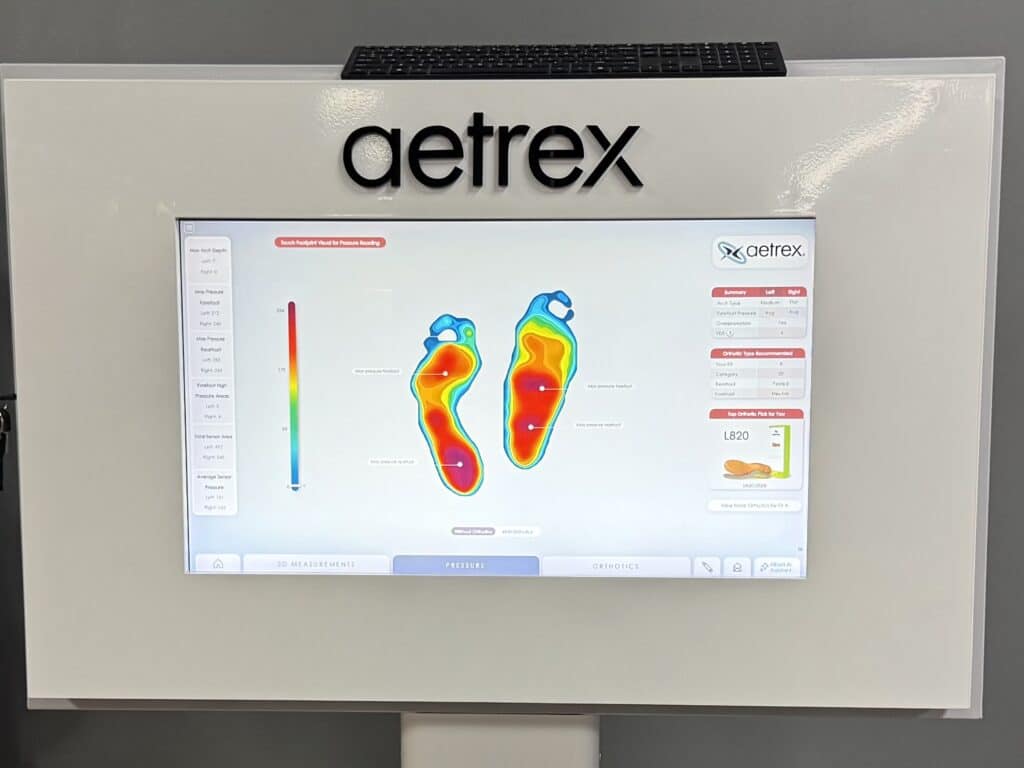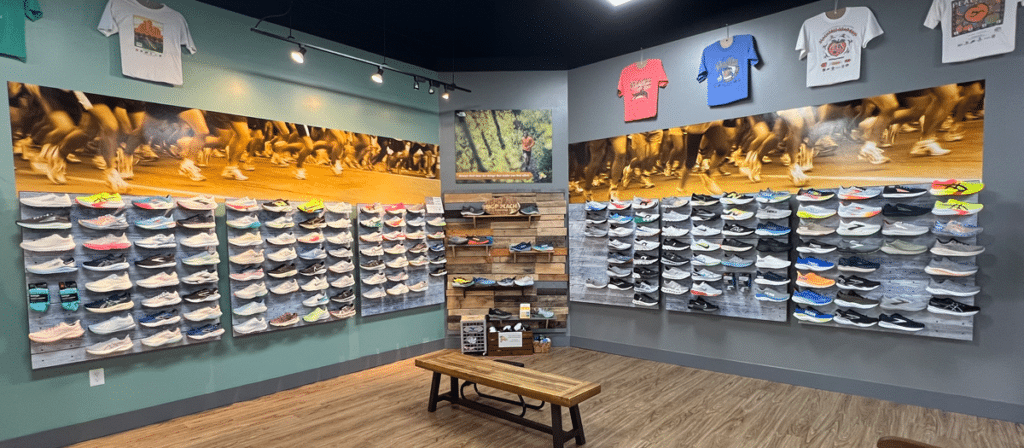Let’s start with a truth bomb: asking “What’s the best shoe for flat feet?” is kind of like asking, “What’s the best car for tall people?” It’s a good question, and also a tricky one. While flat feet are a real thing, the right shoe isn’t a one-size-fits-all answer.
At Big Peach East Cobb, we hear this question a lot. It’s one of the most common things people type into Google, and it’s something we work through with real people, real feet, and real fit needs every day. So let’s unpack it the Big Peach way, with a blend of science, storytelling, and straight talk.

First Things First: What Is a Flat Foot?
If you’ve ever looked at your wet footprint and seen almost the whole bottom of your foot, you’ve probably thought: “I must have flat feet.” Maybe. Maybe not.
Most people who think they have flat feet actually have what’s called a flexible or overpronated foot, meaning the arch looks flat under weight but isn’t structurally collapsed. A truly flat foot is more rare, and you’ll often see the foot curve outward with a very wide midfoot base. But we won’t nitpick. Flat-ish or flat-flat, here’s the key point:
It’s not about the shape of the foot at rest. It’s about what the foot does when you move.
So… What Shoes Are Best for Flat Feet?
At Big Peach East Cobb, we use our fit process, which includes foot scanning, video gait analysis, and real-life testing, to evaluate what your feet actually need.
Flat feet, or overpronated feet, often benefit from stability running shoes, but that’s not a blanket rule. Here’s what we’re really looking for:
- Accommodate Foot Characteristics: Flat feet are often, though not always, wider feet. That means width and possibly volume will be critical for fit. You want a shoe that gives your toes room in length, width, and height. Cramped toes lead to unhappy feet. Translation: wide running shoes for flat feet are often a good starting point.
- Provide a Stable Platform: If your foot rolls inward too much when you walk or run, we might recommend a supportive running shoe with medial posting, guide rails, or a wider base. These features can help reduce stress on the arch, ankle, shin, and knees. But not everyone needs this. Most of the brands we carry offer excellent stability options, so footwear choices will be plentiful.
- Protect from Impact: Whether you’re running a marathon or standing all day at work, you don’t want your shoes to feel like bricks. We look for cushioning that fits your activity and foot type, especially if your foot doesn’t naturally absorb shock well, which can happen with flat arches.

Wait, So Is That It? Just Give Me a Stability Shoe and I’m Good?
Not quite. We’ve seen plenty of folks with “flat feet” who move beautifully in a neutral shoe. Others need an extra boost from an over-the-counter insert, especially if they have pain. That’s why we rely on video gait analysis. We watch you move in the shoe, not just talk about what your arch looks like barefoot. As we like to say: the best shoe for flat feet is the one that works for your feet, your gait, and your goals. And figuring that out is what we’re here for.
When to Add an Insert
Sometimes, a shoe needs backup. If your flat feet are causing ankle pain, shin pain, or plantar fasciitis, a supportive insert can give that extra assist. It’s not cheating. It’s optimizing. We often recommend inserts for those who need a little more structure right now, especially during periods of increased activity or discomfort.
Bonus: Your Use Case Matters
Are you walking at the river, hitting the gym, or training for a marathon? That context matters. Shoe recommendations for a retail worker with flat feet likely won’t be the same as a triathlete’s. We will factor in what you’re using your shoes for just as much as your arch type. And we will make sure you leave with something that feels amazing, not just something that sounds right on paper.
What to Look For in a Shoe for Flat Feet
- Roomy toe box, especially in width and volume
- Secure midfoot and heel fit, a gentle hug, not a bear hug
- Medial support if overpronation is present
- Adequate cushioning for impact protection
- Consider an insert for extra support if pain is present
Still unsure? Walk into Big Peach East Cobb. We will walk through it together. Literally.
FAQs: Shoes for Flat Feet
Not always. If your gait is stable, even with flat feet, a neutral shoe might be perfect.
It’s usually worth considering, but not always. We also need to take foot volume and shape into account, not just width.
Sometimes, but we like to see the shoe perform on its own first. If you’re experiencing aches and pains, or have a specific reason for an insert, such as plantar fasciitis, they can complement your shoe’s support.
There isn’t one best brand for flat feet. We carry a wide variety of brands, such as Brooks, Hoka, Asics, New Balance, On, and more, so we can accommodate many different foot shapes, movement patterns, stability needs, and cushioning preferences. Come try a few and feel the difference.
Absolutely. Our full foot scan and gait analysis are complimentary every day. No appointment needed.
Find Your Fit at Big Peach East Cobb
Flat feet aren’t a flaw. They’re simply your feet. The right pair of shoes can make movement feel better than ever. Whether you are walking the dog, working long shifts, or training for your next race, let’s find the pair that works for you.


